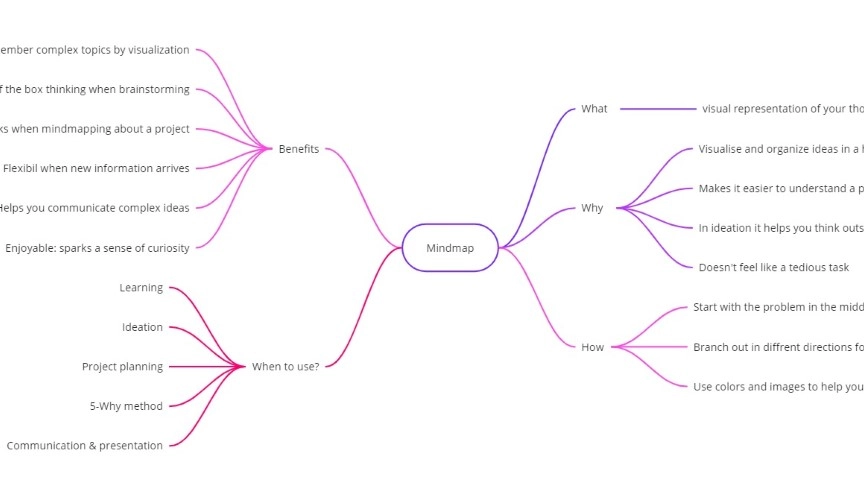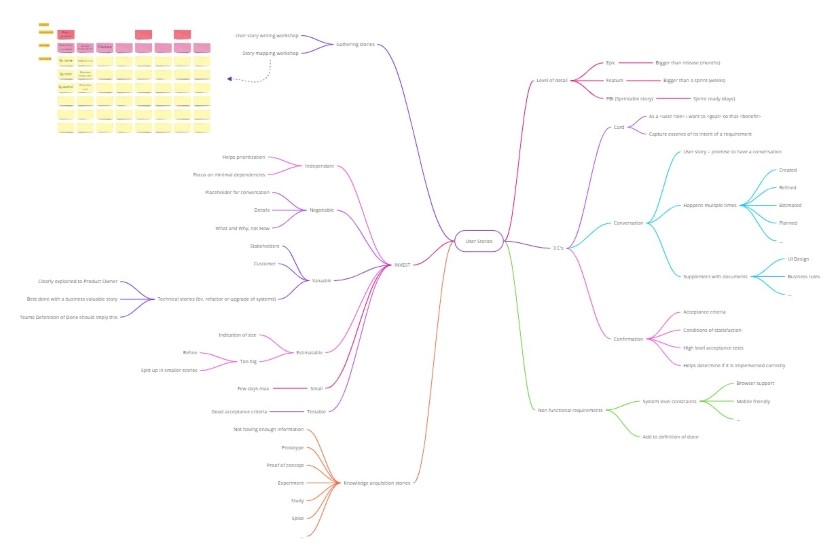How to Mind Map: A Step-by-Step Guide to Visualizing Your Ideas
How to Mind Map: A Step-by-Step Guide to Visualizing Your Ideas
Introduction to mind maps
Mind mapping (concept mapping, brain mapping, or thinking maps) allows visualization of your thoughts. It can be a powerful visual thinking tool when studying, brainstorming, or understanding a complex problem/topic.
Why should you mind map?
Mind mapping is the visualization of your thoughts. It is a great way to visualize and organize ideas hierarchically. A complex problem stays a complex problem when you don't write it down—doing it the old school way by writing it down on paper logically by using headings and so forth makes it a tedious task. When you write everything down using titles, you write down your thoughts, which aren't visualized. This makes it harder to remember what you've learned.
The mindmap brings the best of both worlds together. A logical way to group thoughts and ideas and the visualization to easily remember and get the mindmap right back in your brain.
In an ideation situation, it helps you think way further than the basic ideas you have. The apparent ideas will be the first branches of your mind map when all the basic ideas are around the main topic you are brainstorming about. It becomes a visual representation and opens up another way of thinking about the topic. You can explore some ideas further by branching out. At the end of your ideation session, you'll see that you have way better ideas than just the basic first thoughts that came to mind.
How to make a mind map
Now that I told you all about this awesome tool. Let's learn how I make a mind map. The good news is. It is straightforward to make!
Materials you'll need to mind map
I highly recommend using an online whiteboard or mind-mapping software to create mind maps. Especially when working in a group setting. It helps you to edit the digital mind maps easily and keeps them tidy.
On the other hand, paper and a pen or a whiteboard are just fine when you initially draw mind maps.
Step-by-step process to a basic mind map
- I Start with the central idea or central image in the middle.
- Then, I branch out in different directions for each topic or idea.
- I use colors and images to help my visualization.
That's it! There are no more mind-mapping rules!
Now you can use this tool to cluster your thoughts, and it helps you understand complex problems/topics.
Here is my mind map about mind mapping. Mindception 🤯. I made this to create this blog!

Benefits of creating mind maps
Soooo, I've covered some of the benefits when you create a mind map in the previous chapters. But here are all the benefits clustered.
When I'm studying a new topic, it is an excellent tool for me to remember the subject matter. The visualization can be easily remembered, and when I repeat what I've learned some days after, it is waaaaaaay easier to remember everything. It can even come to a point where I can visualize the mindmap with... my mind. Pure shock
In ideation, it helps me think more outside of the box. All of my obvious first ideas are the starting point to help me go further and become more creative. By branching out further on my basic ideas, I open a new realm of crazy ideas.
Using it for project planning, it can make it easier to identify critical tasks. A mindmap is also easy to update when there is new information about a project. I still need to try this one out. I'll update the blog post once I do!
Imagine you just studied or analyzed a complex topic and must communicate this to your team. You can make a PowerPoint, but why bother if you just made a mindmap? Just use the mindmap as your communication tool to help the team visualize the complex material they need to understand when working on a project.
It helped me coach one of the product owners around the scrum practices and how to write killer user stories!
When to use mind mapping and how to use it for that situation?
Hmmm, I've told you some situations where I use mind mapping. But how would I use them for every specific situation?
Learning
Students listen up! Learning a complex topic isn't always as easy as I hoped. Here is how I use mind mapping to enhance my learning process:
- Write the main topic in the middle of the page.
- For each subtopic, I make a new branch. This is, most of the time, each chapter in a book or lecture.
- Divide your main branches even further with the essential information.
- Add images, notes, examples, and other supporting materials to your branches.
These are the basic steps you need to take when studying. When I'm learning a new topic from a book, I read a chapter. After I finish the chapter, I add a new branch for the chapter to the mindmap and start branching out until I think I've covered the most critical information.
Here is a mindmap I made about user stories in the Scrum Framework. (ps. This is the one I used to coach the product owner 😜.)

- I review the mind map to reinforce what I've covered. Then I try explaining to my imaginary friend - Henry is what I call him - what I just learned. I will keep reviewing my mind map for the next couple of days.
- Last but not least, I let the wonder of mind mapping make my learning experience more fun. When I now try to explain the topic I've learned to my colleagues, I see that I've remembered the mind map and all the connections I've made.
Ideation
Brainstorming is a difficult task, especially when I try to generate ideas out of the box. I use the mind mapping technique for creative thinking alone or in a group to visualize creative ideas.
Single ideation
- I start with the central concept I'm ideating about in the middle. Let's say dinner with friends.
- I connect to the main topic, branching out from the center. Each time I branch out. I Ask myself: "What else can I add to this related topic?" (e.g. everyone in the garden, make your own sandwiches...). If I think an idea will create a whole new cluster, I draw a rectangle around it and treat it as a new Hub different from my main topic.
- I use each connection as a spark for new ideas. Thinking in different directions about each branch.
- I add drawings, images, notes, and other related content to visualize your idea further.
Set a timer for a maximum of ⏰ 60 minutes. You don't want to keep ideating into oblivion.
Team ideation
In a team setting, mind mapping can be a great tool to communicate your thoughts. Most of the time, a team ideates with sticky notes for a set amount of time, like the 10 for 10 exercise.
Why not replace the sticky notes with a mindmap for each individual? I still need to try this one out in a group, but I'll update the blog when I do it!
- I'd set a timer for 15-30 minutes around a problem we need to ideate about.
- I'd let each team member present their mind map to the team as the team presents their mind maps. The facilitator starts creating an aggregate mind map of the session.
Each person gets a maximum of ⏰ 5 minutes to present their mindmap. You can play with these timings, of course.
- I'd review the aggregate mind map and decide what idea to execute.
5-Why method
When I do a retrospective, a mind map can be a handy tool to brainstorm on a topic we want to improve. To fully understand a topic, I use the 5-why questions exercise to grasp our minds around it. The first issue we think is the root problem is most likely not the root cause of our problem. Using the 5-why method, you can better understand the root cause of your problem.
The 5 why exercise will go as follows:
- I write the main topic you want to improve in the middle.
- I ask myself the question: "Why would this issue be happening?" I branch out on each thought I have about the root cause.
I do this for ⏰ 5-10 minutes max
- When I've got many basic causes, I pick one that I think is the most likely cause and ask myself again. Why would this be happening? I branch out for every cause I find.
Repeat this 4 times until you are 5 why's deep.
- If we have spare time in our session. We pick another root cause and repeat step 3.
- When we fully understand the underlying problem, we can start our ideation session about the root cause. You can use a mindmap for team ideation😉.
Project planning
Starting a new project can be daunting to start. The mind map gives me a great start for planning projects since I can alter it when new information comes in. I still haven't tried this one out in real life, but I'll update the blog once I do!
To use the mind map for a project, I'd use the following steps:
- I'd write the main goal in the middle of your mind map.
- Then, I'd mark each branch with the main goal as a major task or milestone that needs to be completed to achieve the goal.
- I'd branch out on each milestone or major task into smaller tasks/milestones.
- I'd review my mind map and identify the most important or time-critical tasks.
- I'd add notes, deadlines, and other information to the mind map to further visualize the project.
- [BONUS] Use the mindmap during the retrospective to review what went well and what could be improved.
Conclusion
In conclusion, mind mapping is a powerful tool for visualizing and organizing ideas and concepts. It can be handy for studying, brainstorming, and understanding complex problems or topics.
By starting with a central idea or problem and branching out to show the relationships between subtopics, I create a comprehensive map of the material I want to learn.
A mind mapping session can help me remember and understand information more effectively, and it can also stimulate creativity and encourage me to think outside the box. Whether studying for an exam, brainstorming ideas for a project, or trying to understand a complex topic, mind mapping can be a valuable tool to help me succeed.

